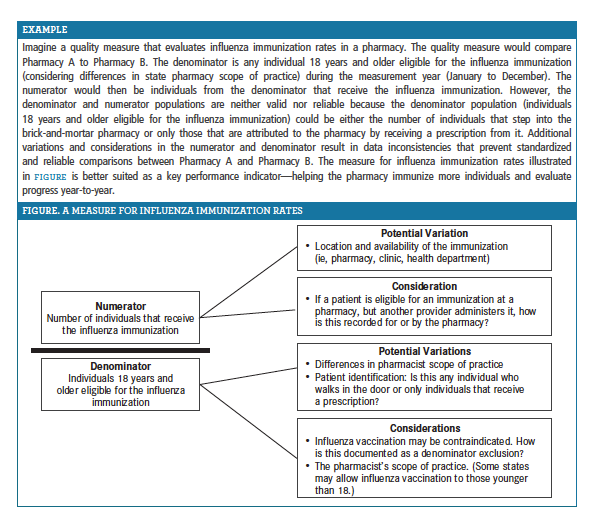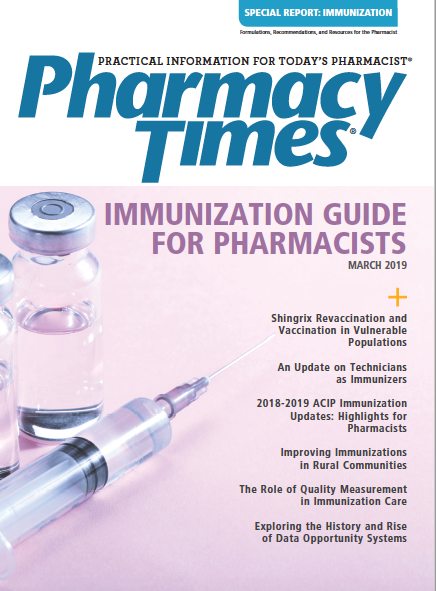Publication
Article
Supplements
The Role of Quality Measurement in Closing Gaps in Immunization Care
The National Quality Strategy aligns the health care community in efforts to improve the quality of health care delivery.
Introduction
A focus on quality in the US health care industry has been increasing since the 1990s when health plans began measuring and publicly reporting their performance on quality metrics. Additionally, federal legislative efforts, such as the Medicare Modernization Act of 2003 and the Patient Protection and Affordable Care Act of 2010, resulted in the National Quality Strategy. The National Quality Strategy aligns the health care community in efforts to improve the quality of health care delivery. This strategy is supported by various stakeholders in the health care community, including organizations that develop and maintain quality measures like the Pharmacy Quality Alliance (PQA).
To incentivize improved and sustained quality care, payment is often tied to performance on quality metrics. Measurement, the process of tracking and reviewing data, remains a foundational tenet of any quality improvement strategy and a powerful lever in the evaluation and comparison of acute, chronic, and preventive care.
As one of the most cost-effective health care investments available, vaccinations are a desirable target for quality measurement. The administration of vaccines is second only to clean water in its reduction of infectious disease burden, according to a 2008 World Health Organization bulletin.1 Similarly, authors on an article published in Philosophical Transactions of the Royal Society B in 2014, which outlined the past, present, and future of the contribution of global health from vaccinations shared that, “…it is indisputable that vaccination has made an enormous contribution to human and animal health, especially in the developing world.”2
The US Department of Health and Human Services Office of Disease Prevention and Health Promotion (ODPHP) provides guidance on public health targets as part of the Healthy People initiative. This broader initiative launched in 1979 through the US Surgeon General’s report and has since evolved to target new goals by the turn of every decade (Healthy People 1990, 2000, 2010, 2020, with planning for 2030 underway).3,4 The US ODPHP plan to improve the health of the US adult population states the increase in life expectancy for the 21st century is largely due to increased immunization rates.5 Within Healthy People 2020, vaccinations have been identified as the most cost-effective clinical prevention services for 17 vaccine-preventable diseases.5 However, a review of Healthy People 2020 targets indicates that the United States is not at goal for any of the 17 diseases recommended for intervention. Based on these metrics there is still opportunity to increase vaccination rates.
Measurement Science
A variety of actions are needed to improve adult immunization rates, including the application of vaccine-related quality measurement. However, a review of the fundamentals of measurement science is beneficial to help understand gaps in immunization quality measures and the opportunities and barriers in this area.
Measurement in health care is often divided into 3 domains based on the elements of care measured: structure, process, or outcomes.6 At the most basic level, structure encompasses the characteristics of providers or organizations, process is the delivery of a specific clinical service, and outcome remains the goal of health care. The development and application of quality measures is based on these domains with each element building upon the next. For example, reduction in readmission (outcome) is achieved through prescribing appropriate therap(ies) (process), which is facilitated through order sets made possible by electronic medical records (structure).
The development of these measure types is focused on scientific acceptability (validity and reliability, or the extent to which a measure captures what it is intended to measure and the degree of precision in its measurement).7 The scientific acceptability of a measure is dependent on the specifications of the measure, and is assessed through testing.

Measures used for accountability and public reporting are performance measures. Performance measures have met the rigorous criteria of importance, feasibility, scientific acceptability, and usability, making them appropriate for performance evaluation at the intended unit of measure (eg, physician to physician comparisons). Performance measures oftentimes are submitted for endorsement consideration by the National Quality Forum.
By contrast, measures used to evaluate internal improvement are key performance indicators (KPIs). These KPIs are not performance measures, despite the similarities between these internal metrics and health care performance measures; KPIs are not specified for comparison due to inconsistencies with any facet of the measure characteristic (denominator exclusions, numerator assessment criteria, target populations/medications, and other variables).
Opportunities and Barriers
Impediments to the exchange of health information and data exist as the most significant barriers to the development and implementation of quality measures focused on immunization care. These impediments include the differences between data sources and data access issues. Data access issues are a product of data silos. In the case of immunizations, access challenges currently prevent the flow of data between a variety of providers and health information repositories, such as state registries, health plan claims, pharmacy management systems, and other sources. (see also exploring the history and rise of data opportunity systems page 18). As noted above, a foundational tenet of health care quality is measurement, and measurement cannot occur without data. In the absence of standardized data, a barrier to performance measure development, KPIs should continue to be used for internal improvement. As standardized data become more readily available, additional immunization-focused performance measures can be developed and implemented.
Conclusion
The PQA is a transparent, consensus-based measure developer, and its roles as measure developer and neutral convener will continue to aid the work in immunization quality measure development. PQA facilitates dialogue and collaboration between various stakeholders across the care continuum to resolve data standardization and access issues. Broader efforts by the organization, past and present, are aimed at prioritizing measure concepts related to immunizations, overcoming challenges associated with quality measure development in the immunization space, and identifying solutions in quality measurement to close the gaps in immunization care.
Loren M. Kirk, PharmD is the Director of Stakeholder Engagement for the Pharmacy Quality Alliance.John A. Galdo, PharmD, MBA, BCPS, BCGP is the Director of Performance Measurement for the Pharmacy Quality Alliance.
References
- Andre FE, Booy R, Bock HL, et al. Vaccination greatly reduces disease, disability, death and inequity worldwide. World Health Organization website.who.int/bulletin/volumes/86/2/07-040089/en/. Accessed October 2018.
- Greenwood B. The contribution of vaccination to global health: past, present and future. Phil. Trans. R. Soc. B. 369(1645):20130433. doi: 10.1098/rstb.2013.0433.
- ODPHP. History & Development of Healthy People. ODPHP website.healthypeople.gov/2020/About-Healthy-People/History-Development Healthy-People-2020. Accessed October 2018.
- Office of Disease Prevention and Health Promotion. Development of the National health Promotion and Disease Prevention Objectives 2030. healthypeople.gov/2020/About-Healthy-People/Development-Healthy- People-2030. Accessed February 2019.
- Office of Disease Prevention and Health Promotion. Immunization and Infectious Diseases. ODPHP website. healthypeople.gov/2020/topics-objectives/topic/immunization-and-infectious-diseases. Accessed October 2018.
- Donabedian A. Evaluating the quality of medical care. Milbank Memorial Fund Q. 1966;44(3)(suppl):166‐206. Reprinted in Milbank Q. 2005;83(4):691‐729.
- Friedberg MW, Landon B. Measuring quality in hospitals in the United States. UpToDate website. uptodate.com/contents/measuring-quality-in-hospitals-in-the-united-states?search=quality measures&source=search_result&selectedTitle=1~150&usage_type=default&display_rank=1. Updated February 13, 2018. Accessed October 2018.







